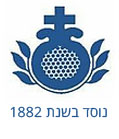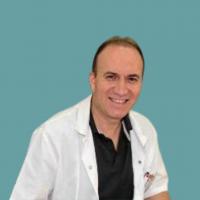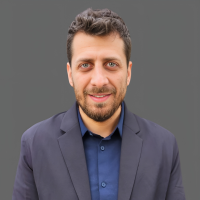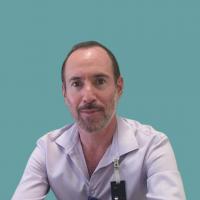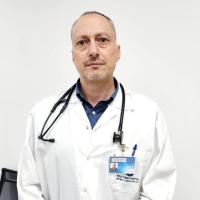הינך נמצא כאן
ד"ר מזיד פלאח
- מנהל מכון מחקר ואחראי רעלים
שפות:
- אנגלית, עברית, ערבית
התמחות:
- ביוכימיה וביולוגיה מולקולרית
שם: ד"ר מזיד פלאח
תפקיד: מנהל מכון מחקר
תואר: Ph.D.
מומחיות: ביוכימיה, ביולוגיה מולקולרית
לימודים: BSc, MSc, PhD and Post-Doc.
מקום ההתמחות: אוניברסיטה העברית, אוניברסיטת מקמאסטר, קנדה.
השתלמויות: טכניון
תחומי התעניינות: מחקר תרגומי - תרפיה מולקולרית ותאית
תפקידים: מנהל מכון מחקר, ראש רשות מחקר, אחראי רעלים.
חברות באיגודים מקצועיים: GRIC (Galilee Research Institute Consortium).
פרסומים מקצועיים :
[1] Falah, M., and Gupta, R. S. (1994) Cloning of the hsp70 (dnaK) genes from Rhizobium meliloti and Pseudomonas cepacia: phylogenetic analyses of mitochondrial origin based on a highly conserved protein sequence, J Bacteriol 176, 7748-7753.
[2] Gupta, R. S., Aitken, K., Falah, M., and Singh, B. (1994) Cloning of Giardia lamblia heat shock protein HSP70 homologs: implications regarding origin of eukaryotic cells and of endoplasmic reticulum, Proc Natl Acad Sci U S A 91, 2895-2899.
[3] Soltys, B. J., Falah, M., and Gupta, R. S. (1996) Identification of endoplasmic reticulum in the primitive eukaryote Giardia lamblia using cryoelectron microscopy and antibody to Bip, J Cell Sci 109 ( Pt 7), 1909-1917.
[4] Falah, M., and Gupta, R. S. (1997) Phylogenetic analysis of mycoplasmas based on Hsp70 sequences: cloning of the dnaK (hsp70) gene region of Mycoplasma capricolum, Int J Syst Bacteriol 47, 38-45.
[5] Gupta, R. S., Bustard, K., Falah, M., and Singh, D. (1997) Sequencing of heat shock protein 70 (DnaK) homologs from Deinococcus proteolyticus and Thermomicrobium roseum and their integration in a protein-based phylogeny of prokaryotes, J Bacteriol 179, 345-357.
[6] Binyamin, L., Falah, M., Portnoy, V., Soudry, E., and Gepstein, S. (2001) The early light-induced protein is also produced during leaf senescence of Nicotiana tabacum, Planta 212, 591-597.
[7] Gepstein, S., Sabehi, G., Carp, M.-J., Hajouj, T., Nesher, Falah, M.. O., Yariv, I., Dor, C., and Bassani, M. (2003) Large-scale identification of leaf senescence-associated genes, The Plant Journal 36, 629-642.
[8] Falah, M., Nassar, T., and Rayan, A. (2009) A simple approach discriminating cardio-safe drugs from toxic ones, Bioinformation 3, 389-393.
[9] Anwar, R., Falah, M., Jamal, R., Hafiz, M., and Nur-Eldin, R. (2010) Assessing Drugs for their Cardio-Toxicity, Letters in Drug Design & Discovery 7, 409-414.
[10] Anwar Rayan and Falah, M. (2010) Sequence specific double-stranded DNA binding compounds, Patent US 2010/0284959.
[11] Falah, M. A. R. a. M. (2011) Sequence Specific Double-Stranded DNA/RNA Binding Compounds and Uses Thereof, Patent PCT/IL2011/000589.
[12] Falah, M., Azab, M., Shdafnay, S., Michaeli, A., and Rayan, A. (2012) Silencing human H4R gene by novel triplex-forming molecule, Inflammation Research 61, S52-S53.
[13] Rayan, A., Falah, M., Raiyn, J., Da'adoosh, B., Kadan, S., Zaid, H., and Goldblum, A. (2013) Indexing molecules for their hERG liability, Eur J Med Chem 65, 304-314.
[14] Alagem-Shafir, M., Kivovich, E., Tzchori, I., Lanir, N., Falah, M. Flugelman, M. Y., Dinnar, U., Beyar, R., Lotan, N., and Sivan, S. S. (2014) The formation of an anti-restenotic/anti-thrombotic surface by immobilization of nitric oxide synthase on a metallic carrier, Acta Biomater 10, 2304-2312.
[15] Srouji, S., Falah, M., Haritan, Y., Tzchori, I., and Flugelman, M. (2014) Albumin Supplementation to Cold Injection Solution increases Viability of Endothelial and Smooth Muscle Cells, Journal of Cell Science and Therapy 5, 1-6.
[16] Falah, M., Rayan, A., and Srouji, S. (2015) Storage effect on viability and biofunctionality of human adipose tissue-derived stromal cells, Cytotherapy 17, 1220-1229.
[17] Falah, M., and Srouji, S. (2015) A discussion concerning direct bone regeneration on and around inserted dental implants in maxillary sinus lifting procedures without any placement of bony substitutes, Int J Oral Maxillofac Surg 44, 1582-1583.
[18] Falah, M., Sohn, D. S., and Srouji, S. (2016) Graftless sinus augmentation with simultaneous dental implant placement: clinical results and biological perspectives, Int J Oral Maxillofac Surg 45, 1147-1153.
[19] Falah, M., and Srouji, S. (2016) Use of Buccal Fat Pad for Closure of Perforation and Graft Material in a Maxillary Sinus Elevation Procedure: A Preliminary Study, Int J Oral Maxillofac Implants 31, 842-848.
[20] Falah, M., and Srouji, S. (2016) Raised Schneiderian membrane compared with peeled bony walls in the formation of bone, Br J Oral Maxillofac Surg 54, 115-116.
[21] Zaid, H., Raiyn, J., Osman, M., Falah, M., Srouji, S., and Rayan, A. (2016) In silico modeling techniques for predicting the tertiary structure of human H4 receptor, Front Biosci (Landmark Ed) 21, 597-619.
[22] Haj, J., Haj Khalil, T., Falah, M., Zussman, E., and Srouji, S. (2017) An ECM-Mimicking, Mesenchymal Stem Cell-Embedded Hybrid Scaffold for Bone Regeneration, Biomed Res Int 2017, 8591073.
[23] Rayan, A., Raiyn, J., and Falah, M. (2017) Nature is the best source of anticancer drugs: Indexing natural products for their anticancer bioactivity, PLoS One 12, e0187925.
[24] Zeidan, M., Rayan, M., Zeidan, N., Falah, M., and Rayan, A. (2017) Indexing Natural Products for Their Potential Anti-Diabetic Activity: Filtering and Mapping Discriminative Physicochemical Properties, Molecules 22.
[25] Aswad, M., Rayan, M., Abu-Lafi, S., Falah, M., Raiyn, J., Abdallah, Z., and Rayan, A. (2018) Nature is the best source of anti-inflammatory drugs: indexing natural products for their anti-inflammatory bioactivity, Inflamm Res 67, 67-75.
[26] Tzchori, I., Falah, M., Shteynberg, D., Levin Ashkenazi, D., Loberman, Z., Perry, L., and Flugelman, M. Y. (2018) Improved Patency of ePTFE Grafts as a Hemodialysis Access Site by Seeding Autologous Endothelial Cells Expressing Fibulin-5 and VEGF, Mol Ther 26, 1660-1668.
[27] Falah, M., Rayan, M., and Rayan, A. (2019) A Novel Paclitaxel Conjugate with Higher Efficiency and Lower Toxicity: A New Drug Candidate for Cancer Treatment, Int J Mol Sci 20.
[28] Gabe, V., Kacergius, T., Abu-Lafi, S., Kalesinskas, P., Masalha, Falah, M., Abu-Farich, B., Melninkaitis, A., Zeidan, M., and Rayan, A. (2019) Inhibitory Effects of Ethyl Gallate on Streptococcus mutans Biofilm Formation by Optical Profilometry and Gene Expression Analysis, Molecules 24.
[29] Sammar, M., Abu-Farich, B., Rayan, I., Falah, M., and Rayan, A. (2019) Correlation between cytotoxicity in cancer cells and free radical-scavenging activity: In vitro evaluation of 57 medicinal and edible plant extracts, Oncol Lett 18, 6563-6571.
[30] Gabe, V., Zeidan, M., Kacergius, T., Bratchikov, M., Falah, M., and Rayan, A. (2020) Lauryl Gallate Activity and Streptococcus mutans: Its Effects on Biofilm Formation, Acidogenicity and Gene Expression, Molecules (Basel, Switzerland) 25, 3685.
[31] Bashkin, A., Ghanim, M., Abu-Farich, B., Rayan, M., Miari, R., Srouji, S., Rayan, A., and Falah, M. (2021) Forty-One Plant Extracts Screened for Dual Antidiabetic and Antioxidant Functions: Evaluating the Types of Correlation between -Amylase Inhibition and Free Radical Scavenging, Molecules 26.
[32] Khalil, T. H., Zoabi, A., Falah, M., Nseir, N., David, D. B., Laevsky, I., Zussman, E., Ronen, O., Redenski, I., and Srouji, S. (2021) Micro-Osteo Tubular Scaffolds: a Method for Induction of Bone Tissue Constructs, Regenerative Engineering and Translational Medicine.
[33] Ayelet Shai, E. G., Reem Miari, Hala Tareef, Marei Sammar, Mouhammad Zeidan, Anwar Rayan and Falah, M. (2022) Inhibiting mutant KRAS G12D gene expression using novel peptide nucleic acid (PNA)-based antisense: A potential new drug candidate for pancreatic cancer, Oncol Letters In Press.
[34] Reema Fadoul, T. H. K., Idan Redenski, Daniel Oren, Asaf Zigron, Avishalom Sharon, Amiel A. Dror, Falah, M., Samer Srouji. (2022) The Modulatory Effect of Adipose-Derived Stem Cells on Endometrial Polyp Fibroblasts, Stem Cells and Development In press.
שטחי תהתעניינות ועיסוק מיוחדים:
My fields of interest are based on areas of my research expertise, namely, applied research in the field of molecular and cellular therapy. Currently, and in the recent past years, I aimed to utilize the therapeutic potential of molecules or components that are either synthetic, derived from natural sources (natural products or plant extracts) or cell secreted. The investigational studies focused on therapeutics for tissue regeneration, diabetes, and cancer diseases, which will be further pursued in my lab. The aim of some of the natural products that are currently being investigated are also geared towards using them as food preservatives.
The current running research and future scientific plans are as follows:
1. Tissue regeneration research
Tissue regeneration is based on the ability of stem cells to repair and restore damaged or diseased tissues. Stem cells are utilized for the purposes of developing functional tissue substitutes and reconstructing damaged tissues or organs. Previously, I investigated mesenchymal stem cells derived from adipose tissues and their ability to differentiate and form bone tissue structures in vivo. Some of my results have been published in scientific articles [1-4]. Additionally, extracellular vehicles (EVs) secreted by mesenchymal stem cells were isolated and utilized to treat fibrosis. Along with an M.Sc. student, we found that these EVs inhibit the growth of fibroblasts derived from ovarian polyps. This work is now being prepared for publication (the manuscript is now being fixed and resubmitted) [5].
2. Research on natural products and diabetes:
I am investigating the effects and mechanism of novel anti-hyperglycemic substances on the α-amylase enzyme and glucose uptake in a diabetic cellular model. The substances employed were either formulated from natural products (approved food additives) or are extracts of local edible plants aimed to advance pre-clinical and clinical research for treatment of patients with type 2 diabetes. Recently, I published an article titled” Forty-One Plant Extracts Screened for Dual Antidiabetic and Antioxidant Functions: Evaluating the Types of Correlation between -Amylase Inhibition and Free Radical Scavenging” [6]. Two natural products that have been investigated and found to have dual antidiabetic and antioxidant activities will be patented and further developed as antidiabetic drugs to be taken together with acarbose (the current approved antidiabetic drug) in an attempt to lower its side effects.
3. Cancer research:
The EVs mentioned above were also derived from mature epithelial cells and utilized to target cancer cell lines. In our current research, I have found that these EVs inhibit growth and cause apoptosis in four breast cancer cell lines. These preliminary studies have been summarized and submitted to the Ministry of Science for further resource recruitment.
Another area of cancer research that I have investigated, was designing and synthetizing chemicals that can specifically and selectively bind to RNA and DNA sequences. Key genes in cancer cell lines were chosen to be targeted by these chemicals aiming to inhibit the expression/activity of the genes. I have investigated whether the binding of these chemicals to the specific gene sequences affects viability of a pancreatic cancer cell line, by inducing apoptotic pathways. The ultimate goal is to develop drugs that specifically silence the targeted gene and inhibit the growth rate of the cancer cells. Based on this research, an article been recently accepted titled “Inhibiting mutant KRAS G12D gene expression using novel peptide nucleic acid (PNA)-based antisense: A potential new drug candidate for pancreatic cancer” [7]. These chemicals are being utilized to silence the expression of the gene ribonucleotide reductase regulatory subunit M2 (RRM2) in breast cancer cell lines. This research project is currently supported by The Ministry for Development of the Periphery, Negev and Galilee.
·
הצוות
ד"ר מזיד פלאחמנהל מכון המחקר |
ד"ר איאד חמאיסימומחה בגסטרואנטרולוגיה |
ד"ר פארס חרבגירופא בית |
דר' מוחמד עואודהמנהל מכון הדיאליזה |
ד"ר האשם בשארהמנהל מרפאת ריאות מומחה רפואה פנימית, מחלות ריאה |
ד"ר פארס חרבגירופא בית |
דר' מוחמד חג'אזימנהל מכון MRI |
ד"ר מועד חוסיןרופא בית |
ד"ר יוסף רוןמנהל המכון לרפואה גרעינית ו- PET-CT |
דר' עדי פרנסיסמנהל טיפול נמרץ לב קרדיולוג |
